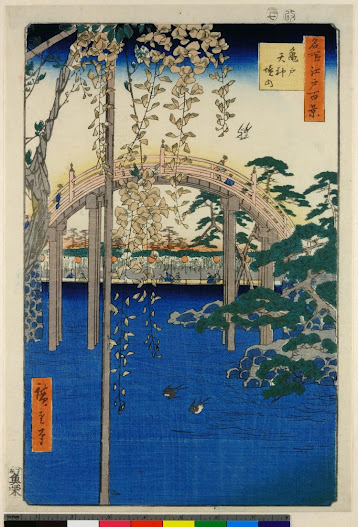Renaissance Blog
The painting shown below is "Primavera" by Alessandro Botticelli. The work of art was produced in 1480 and is currently housed at The Uffizi Museum. This piece was crafted on a poplar wood backing using tempera paint.
This work is so breathtaking. The detail that Botticelli captures in the painting is almost hard to believe. Specifically, the translucent fabric effect that he pulls off so effortlessly. His use of very dark color in the background makes the figures pop out, making their skin looks radiant and shimmery, almost gold-like. The array of flora in the scene is quite incredible. There have been at least 138 different species of plants identified within this piece, all of them being accurately portrayed by Botticelli. This painting is titled "Primavera", which means Spring when translated from Italian. The artists' use of mythological symbolism here is apparent as we see Zephyrus, God of the West Wind, taking Chloris (nymph of spring). She is then transformed into Flora, the goddess of flowers. Flora is associated with fertility of the land and spring. In this painting we also see Venus, goddess of love and beauty, directly centered. Behind her, the gap in the trees creates an arch-like effect, drawing the viewer's eyes to her. I think this could also be significant, as her position and stance in the background possesses a holy quality. It reminds me quite a bit of Mary, mother of Jesus. Above her, we see a blinded cupid shooting an arrow down below. Cupid's position above Venus, could be purposeful due to her being the goddess of love.
This piece was said to have been commissioned by a member of the Medici Family. This is apparent with the orange trees depicted in the painting, something you will notice show up in many of the paintings done for the Medici Family. Oranges are a reference to the family, as they were known for their extensive citrus tree collection.
This painting is displayed in a museum currently, within an intricate gold frame. I think this is quite fitting considering the time piece of the work and the golden hues of the figures within the image. The piece is 207 cm x 319 cm, so it is a very large painting. That being said, I think a copy of this painting would look lovely within a home and I would absolutely enjoy owning one. A better understanding of mythology would likely make me even more appreciative of the work.
Bibliography
Daniela Parenti, "Spring" in Le Gallerie Degli Uffizi, accessed February 19, 2024, https://www.uffizi.it/en/artworks/botticelli-spring.
Dr. Beth Harris and Dr. Steven Zucker, "A-level: Sandro Botticelli, La Primavera (Spring)," in Smarthistory, May 22, 2017, accessed February 19, 2024, https://smarthistory.org/sandro-botticelli-la-primavera-spring-2/.



Hi Lauren! Its so cool that there are 138 species of plants in this painting. It is impressive that it can have so much accuracy and detail, yet still portray such a whimsical fairytale-like scene. In addition to the role of the Medici family in the creation of this painting, the return to Roman influences that took place during the Renaissance is also evident in this painting's depiction of Roman mythology.
ReplyDeleteHi Lauren, this is a great painting. I agree with you on how you say that the background is dark, which makes the people pop out more in a way that it looks like they are glowing. I thought the same, perfectly said. The layers of a sheer, see through cloth over the people is well done. At first glance, I enjoyed reading your blog, great work!
ReplyDeleteHey Lauren! I really love the art piece you chose for this blog. I agree with you that having the background being all dark really brings out the light golden colors of the figures in the painting. It's impressive that someone could identify 138 different species of plants in this piece, I don't think I can even spot one. What I also love about this piece is that it mentioned mythology of the god of west wind taking a nymph. It's amazing that Botticelli was able to paint something so fairytale like, it looked like it can be part of a Greek mythology book.
ReplyDeleteHi Lauren! I too love how the gold colors stand out with the darker background! I find the use of mythological symbolism interesting in this case, as it represents Greek and Roman mythology, and not the Christian faith which was especially popular during this time. This piece also seems to make use of natural patterns for the flora which add extra detail. This blog post was great, thanks for the enjoyable read!
ReplyDelete